As an Amazon Associate I earn from qualifying purchases.
Are you a grilling newbie? Look no further! This comprehensive guide has got you covered.
We’ll show you the ropes, from choosing the perfect grill to mastering those mouthwatering marinades.
With essential tips and tricks, you’ll be grilling like a pro in no time.
Get ready to impress your friends and family with your sizzling skills.
So, grab your apron and fire up that grill – it’s time to join the grilling community and become the ultimate backyard chef.
Key Takeaways
- Consider gas or charcoal options
- Gas grills offer convenience and quick ignition
- Clean grill after each use to prevent buildup of grease and food residue
- Choose a flat and stable surface for grilling
Choosing the Right Grill
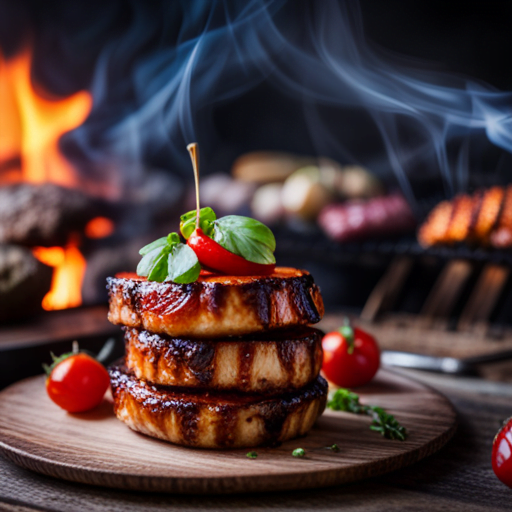
When it comes to choosing the right grill, there are some key factors to consider.
Firstly, you’ll want to decide between gas and charcoal. Gas grills offer convenience and quick heat up times, while charcoal grills provide that classic smoky flavor.
Next, think about the size of the grill. This is important depending on how much cooking space you need.
Lastly, consider the portability of the grill. If you plan on taking your grill on the go, then portability is a must.
Taking these factors into account will help you make the best decision when choosing a grill.
Gas Vs. Charcoal
When it comes to flavor preference, it’s important to consider whether you prefer the smoky taste of charcoal or the clean, consistent flavor of gas.
Gas grills are known for their ease of use, with quick ignition and precise temperature control, making them perfect for beginners.
On the other hand, charcoal grills require more time and effort to light and maintain, but many argue that the unique flavor it imparts to the food is worth the extra steps.
Flavor Preference: Gas or Charcoal
The flavor of food cooked on a gas grill versus a charcoal grill can vary significantly. When it comes to flavor preference, it’s a matter of personal taste. Gas grills offer convenience and temperature control, making them perfect for beginners.
On the other hand, charcoal grills provide a smoky flavor that many people love. It’s important to consider the pros and cons of both options and experiment to find what suits your palate best. Avoid beginner mistakes by following recipes and mastering the art of temperature control.
Ease of Use: Gas Vs. Charcoal
Gas grills are generally easier to use than charcoal grills due to their convenience and temperature control. If you’re a beginner who wants a sense of belonging in the grilling world, gas grills are your go-to. They require less grill maintenance and provide better fuel efficiency.
With precise temperature control and even heat distribution, you can easily master various cooking techniques. So, fire up your gas grill and become a grilling pro in no time!
Size and Portability
When it comes to choosing the ideal grill size, there are a few key factors to consider.
Firstly, think about the amount of space you have available in your backyard or patio.
Secondly, consider the number of people you typically cook for.
And finally, take into account the types of food you like to grill, as certain dishes may require more surface area.
Additionally, if you’re someone who loves to grill on the go, it’s worth exploring the portable options available.
These compact grills are perfect for camping trips, tailgating, or picnics in the park.
They offer convenience and versatility without sacrificing the flavor and quality of your grilled meals.
Ideal Grill Size
To find the ideal grill size for your needs, consider how many people you typically cook for.
When it comes to grill maintenance, make sure to clean it regularly using proper cleaning techniques.
For grill storage, find a safe and dry place to keep it when not in use.
To enhance your grilling experience, invest in grill accessories like spatulas, tongs, and thermometers.
Lastly, prioritize grill safety by following all recommended safety guidelines.
Portable Options Available
There’s a wide selection of portable grills on the market that are perfect for outdoor cooking on the go. Portable grilling options offer convenience and flexibility, allowing you to enjoy delicious grilled food wherever you go.
The benefits of portable grills include their compact size, easy setup, and ability to cook a variety of foods. To make the most out of your portable grill, choose one that suits your needs, follow safety tips, and maintain it regularly for optimal performance.
Essential Grilling Tools
When it comes to grilling, having the right tools is essential. From a sturdy pair of tongs to a reliable meat thermometer, there are a few must-haves that every grill master should have in their arsenal.
In this discussion, we will explore the key points of must-have grilling tools and offer some tips on how to choose the right tools for your grilling needs.
Must-Have Grilling Tools
You’ll need a few must-have grilling tools before you get started. Here are our top picks for essential equipment that will make your grilling experience a breeze:
- Grill brush: Keep your grill grates clean and ready for cooking.
- Tongs: Perfect for flipping burgers, sausages, and vegetables without losing any precious juices.
- Meat thermometer: Ensure your meat is cooked to perfection, without any guesswork.
- Grill spatula: Ideal for flipping delicate fish or large cuts of meat with ease.
- Grill gloves: Protect your hands from the heat while maneuvering hot grates and utensils.
These tools are essential for any grilling enthusiast and will help you become a master of the grill in no time. So gather your must-haves, fire up the grill, and get ready to enjoy some delicious barbecue!
Choosing the Right Tools
Choosing the right tools for grilling is essential to ensure a successful and enjoyable barbecue experience. With the right grilling utensils and accessories, you can become the grill master of your dreams. To help you get started, here is a list of must-have grilling equipment:
| Grilling Tool Set | Grilling Utensils | Grilling Gadgets |
|---|---|---|
| Tongs | Grill brush | Meat thermometer |
| Spatula | Skewers | Grill mat |
| Grill fork | Basting brush | Smoker box |
Having a complete grilling tool set will make your cooking process easier and more efficient. From flipping burgers to basting ribs, these utensils are designed to handle the heat and help you achieve the perfect char on your food. Additionally, grilling gadgets such as a meat thermometer and grill mat can take your grilling game to the next level.
Preparing the Grill
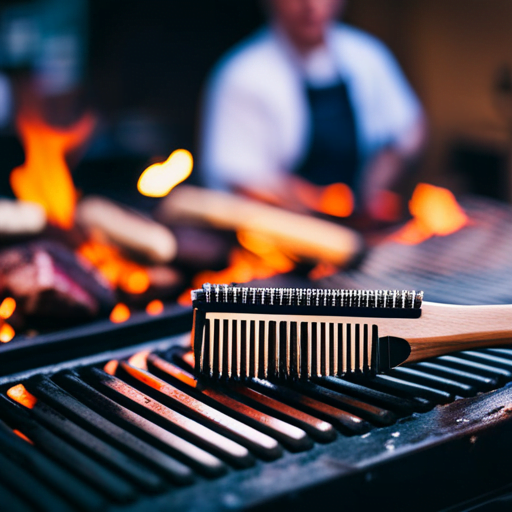
Now that you’ve got your essential grilling tools ready, it’s time to prepare the grill for cooking.
One important step is cleaning the grill thoroughly to remove any leftover food residue or grease. This ensures optimal heat distribution and prevents any unwanted flavors from transferring to your food.
Cleaning the Grill
Cleaning the grill regularly is essential to prevent buildup and maintain optimal grilling performance. To keep your grill in top shape, here are some important tips to follow:
Grill maintenance: Make it a habit to clean your grill after each use to prevent grease and food residue from accumulating.
Removing grease: Use a grill brush to scrape off any grease or residue from the grates. This will help prevent flare-ups during cooking.
Grill brush techniques: When using a grill brush, apply firm pressure and scrub the grates in a back-and-forth motion. This will effectively remove any stuck-on debris.
Deep cleaning: Periodically, give your grill a thorough deep cleaning. This involves disassembling the grill, cleaning the burners and other components, and removing any built-up grease.
Grill maintenance checklist: Create a checklist to ensure you don’t miss any important steps in maintaining your grill. This will help you keep track of when to clean, replace parts, and perform other necessary maintenance tasks.
Proper Heat Distribution
To achieve evenly cooked food, it’s important to ensure proper heat distribution on the grill. Heat distribution techniques play a key role in achieving even heat throughout your grill.
One effective method is to manage hot spots by moving the food around during cooking. This prevents certain areas from getting too hot while others remain cooler.
Another technique is indirect heat cooking, where you place the food away from the direct flames. This allows for more gentle and even cooking, reducing the risk of burned or undercooked spots.
Controlling flare ups is also crucial for maintaining even heat. By reducing the amount of fat dripping onto the flames, you can prevent sudden bursts of intense heat.
Understanding Direct and Indirect Heat
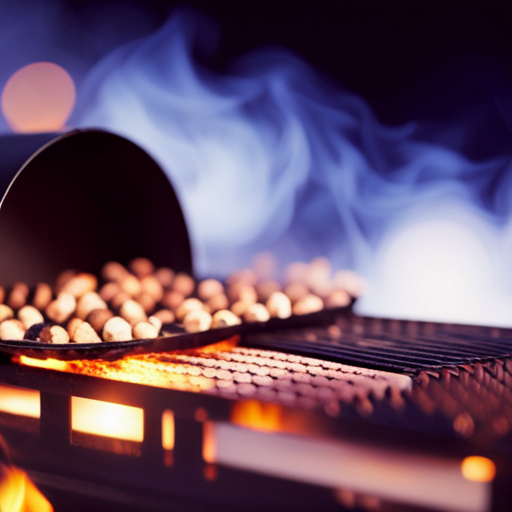
When it comes to mastering the art of grilling, there are a few key points you need to understand.
First, you’ll need to learn about heat control techniques to ensure your food is cooked to perfection.
Next, cooking time variations are crucial to achieving different levels of doneness.
Finally, flavor infusion methods can take your grilling game to the next level by adding depth and complexity to your dishes.
Heat Control Techniques
One key technique for controlling heat on the grill is by adjusting the vents. By manipulating the vents, you can regulate the flow of air, which in turn affects the temperature inside the grill.
Here are some heat control techniques to help you achieve the perfect cookout:
Temperature Management: Be mindful of the temperature you want to achieve and adjust the vents accordingly.
Indirect Grilling: Create a two-zone fire by placing the coals on one side of the grill and the food on the other side. This allows for slower cooking without direct heat exposure.
Searing Techniques: For a delicious crust, sear your meat over direct heat for a short period, then move it to indirect heat to finish cooking.
Flame Control Strategies: Control flare-ups by closing the grill lid, moving the food away from the flames, or spraying water on the coals.
Experimentation: Don’t be afraid to try different heat control methods until you find what works best for you.
With these heat control techniques, you’ll be able to master the art of grilling and enjoy mouthwatering meals with friends and family.
Cooking Time Variations
Achieving the perfect cookout involves experimenting with cooking time variations to determine the ideal duration for each type of food.
When it comes to grilling, it’s all about finding the right balance between tenderness and flavor. Cooking time variations play a crucial role in achieving this balance.
For meats, such as steak or chicken, different cooking times can result in varying degrees of tenderness. It’s important to adjust the cooking time based on the thickness and cut of the meat.
Additionally, cooking time variations can also impact flavor combinations and infusion. Longer cooking times allow for more flavor infusion, while shorter cooking times retain the natural flavors of the ingredients.
Flavor Infusion Methods
Flavor infusion methods are essential for enhancing the taste of grilled dishes. To take your grilling game to the next level, here are some flavor infusion techniques you can try:
Marinade Tips: Marinating your meat or vegetables before grilling can add depth and richness to the flavors. Experiment with different marinades, such as teriyaki, citrus-based, or herb-infused, to find your favorite.
Seasoning Suggestions: Don’t be afraid to be generous with your seasonings. A mix of salt, pepper, garlic powder, and other spices can elevate the taste of your grilled dishes.
Brining Methods: Brining involves soaking your meat in a saltwater solution before grilling. This technique helps to retain moisture and adds flavor to the meat.
Smoking Techniques: Smoking your food can add a smoky, robust flavor. Use wood chips or a smoker box to infuse your grilled dishes with a delicious smokiness.
Mastering the Art of Marinades and Rubs
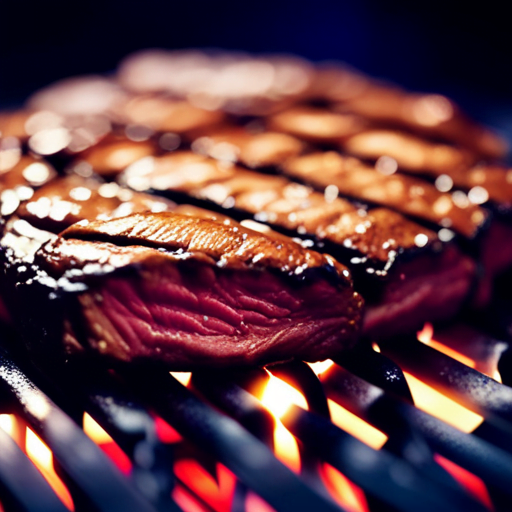
When it comes to creating the perfect flavor combinations for your grilled meats, there are a few key points to keep in mind.
First, you’ll want to consider the type of meat you’re working with and choose flavors that complement it.
Second, experimenting with different marinades and rubs can help enhance the tenderness of your meat, making it even more enjoyable to eat.
Lastly, don’t be afraid to get creative and try out new flavor combinations to truly elevate your grilling experience.
Perfect Flavor Combinations
To enhance your grilling experience, you’ll want to explore a variety of flavor combinations for your dishes. Playing with different flavors can elevate your grilled meals to a whole new level.
Here are some flavor pairing ideas to inspire your culinary adventures:
- Sweet and Spicy: Try combining honey and sriracha for a delicious kick.
- Classic Herbs: Rosemary and thyme make a perfect pairing for grilled chicken or vegetables.
- Citrus Burst: Add a zesty twist by using lemon or lime juice in your marinades.
- Smoky Delight: Enhance the flavor of your meats with a blend of paprika, cumin, and garlic powder.
- Taste Test: Don’t be afraid to experiment with different seasoning combinations. Taste testing is key to finding your perfect flavor profile.
With these spice combinations, marinade recipes, seasoning tips, and taste testing techniques, you’ll have the confidence to create mouthwatering dishes that will make you the star of any grilling gathering. Happy grilling!
Enhancing Meat Tenderness
Now that you know the perfect flavor combinations, it’s time to dive into enhancing the tenderness of your meat.
Marination is a key technique that will make your meat melt in your mouth. By soaking your meat in a mixture of spices, herbs, and acids like vinegar or citrus, you’ll infuse it with amazing flavors and tenderize it at the same time.
Another technique to try is brining, which involves soaking your meat in a saltwater solution. This not only adds moisture to the meat, but also helps break down tough fibers, resulting in a more tender and juicy end product.
Slow cooking is another great method for achieving tender meat. Low and slow cooking allows the collagen in the meat to break down, resulting in a tender and flavorful dish.
Lastly, don’t forget to let your meat rest after cooking. This allows the juices to redistribute, giving you a juicy and tender bite.
Perfecting Grilling Times and Temperatures
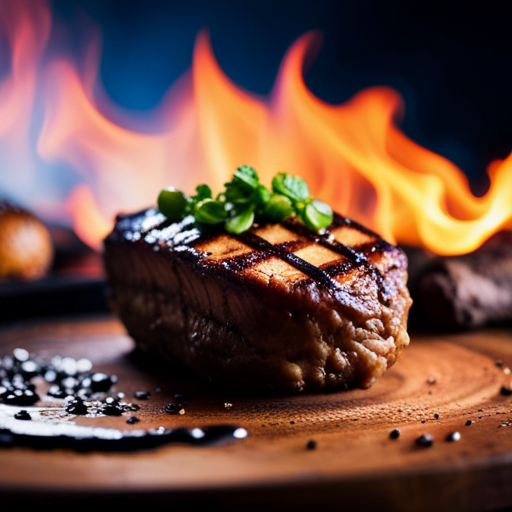
It’s important to get the grilling times and temperatures just right for perfectly cooked food. When it comes to grilling, timing and temperature control are crucial for achieving that tender and flavorful meat you crave. Here are some tips to help you perfect your grilling technique:
Use a meat thermometer to accurately gauge the internal temperature of your meat. This ensures that it’s cooked to the desired level of doneness.
Preheat your grill before cooking to create a sear on the meat, sealing in the juices and enhancing the flavor.
Adjust the heat source and cooking time based on the thickness and type of meat you’re grilling. Thicker cuts require lower temperatures and longer cooking times, while thinner cuts need higher temperatures for shorter periods.
Consider indirect grilling for larger cuts of meat, such as roasts or whole chickens. This method allows for more even cooking and prevents the meat from drying out.
Experiment with flavor infusion by using marinades, rubs, and wood chips for smoking. These techniques can add depth and complexity to your grilled dishes.
Grilling Different Types of Meat and Seafood
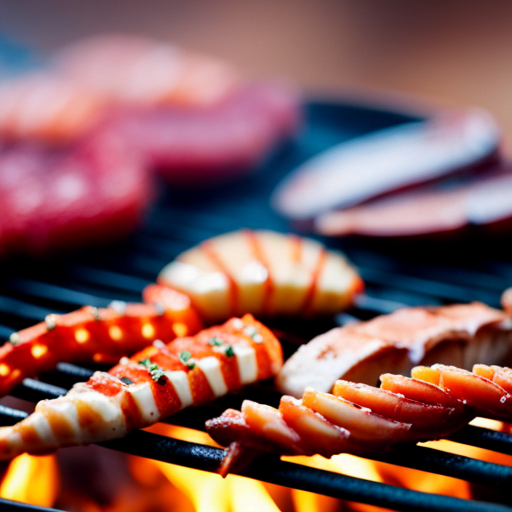
When it comes to grilling different types of meat and seafood, there are a few key points to keep in mind.
First, mastering steak grilling techniques is essential for achieving that perfect juicy and flavorful steak.
Second, learning how to grill shrimp to perfection will elevate any seafood lover’s grilling game.
And finally, grilling chicken breasts requires a delicate balance of heat and time to ensure they are cooked through without drying out.
Additionally, we’ll be sharing some helpful tips for cooking fish on the grill, so you can enjoy a perfectly grilled seafood feast.
Steak Grilling Techniques
To achieve a perfect steak on the grill, start by properly seasoning the meat. This step is crucial in enhancing the flavor and tenderness of your steak. Rub a blend of herbs, spices, and salt onto your steak to add depth of flavor.
Next, preheat your grill to high heat for a delicious sear, then reduce the heat to medium for even cooking. This will ensure that your steak is cooked to perfection.
Use a meat thermometer to determine the doneness of your steak. Rare is around 125°F, medium-rare is 135°F, and well-done is 160°F. This will help you achieve the desired level of doneness for your steak.
After grilling, allow your steak to rest for a few minutes. This will help lock in the juices and ensure a juicy, flavorful bite.
Lastly, choose the right cut of steak for grilling, such as ribeye, New York strip, or filet mignon. These cuts will maximize tenderness and flavor.
Perfectly Grilled Shrimp
Now that you’ve mastered the art of grilling steak, it’s time to move on to another delicious dish: perfectly grilled shrimp. Get ready to impress your friends and family with juicy and flavorful shrimp that will make them feel like they belong at a fancy seafood restaurant.
To start, sprinkle your shrimp with a delicious grilled shrimp seasoning. This will add a burst of flavor to your dish.
Next, thread the shrimp onto grilling shrimp skewers for easy flipping and even cooking.
If you want to take your grilled shrimp to the next level, try marinating them before grilling. A simple marinade for shrimp made with garlic, lemon juice, and olive oil will infuse your shrimp with incredible flavors.
Another fantastic way to grill shrimp is by using a plank. Grilling shrimp on a plank adds a smoky and woodsy flavor that will make your taste buds dance with joy.
Once your shrimp are perfectly grilled, use them to create mouthwatering grilled shrimp tacos. Fill warm tortillas with your grilled shrimp, fresh veggies, and a squeeze of lime for a delicious and satisfying meal.
With these tips and techniques, you’ll become a master of grilling shrimp in no time. Your loved ones will feel a sense of belonging as they gather around the table to enjoy your scrumptious creations.
Grilling Chicken Breasts
You can easily achieve juicy and flavorful chicken breasts on the grill by marinating them in a delicious blend of herbs and spices.
Here are some grilling techniques and tips to help you succeed:
- Preheat your grill to medium-high heat to ensure even cooking.
- Marinate the chicken breasts for at least 30 minutes to allow the flavors to penetrate the meat.
- Experiment with different seasoning ideas, such as a Mediterranean blend or a spicy Cajun rub, to add variety to your grilled chicken.
- Cook the chicken breasts to an internal temperature of 165°F to ensure they are fully cooked and safe to eat.
- Avoid common grilling mistakes, like overcrowding the grill or flipping the chicken too often, to prevent dryness and ensure a perfect result.
Tips for Cooking Fish
If you’re craving a delicious seafood dish, consider trying out different marinades and seasonings to enhance the flavor of your grilled fish. Cooking fish on the grill can be a wonderful way to enjoy its delicate flavors. To ensure your fish turns out perfectly every time, there are a few key cooking techniques and considerations to keep in mind. First, choose a fish that is firm and sturdy enough to withstand grilling, such as salmon or tuna. Next, maintain a medium-high grilling temperature, around 350-400°F, to prevent the fish from sticking to the grill. As for seasoning options, you can experiment with a variety of flavors, from simple lemon and herbs to spicy Cajun or tangy teriyaki. Lastly, don’t forget to regularly clean and maintain your grill to prevent any fishy odors or flavors from transferring to future meals.
| Cooking Techniques | Seasoning Options |
|---|---|
| Grilling | Lemon and herbs |
| Baking | Spicy Cajun |
| Broiling | Tangy teriyaki |
| Pan-searing | Garlic and butter |
Safety Tips for a Successful Grilling Experience
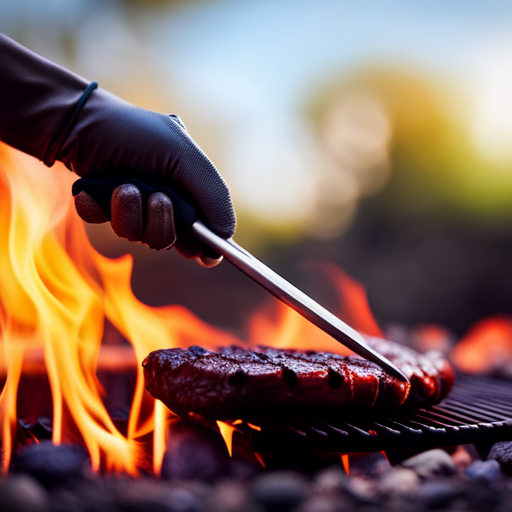
To ensure a successful grilling experience, it’s important to prioritize safety. Here are some key tips to help you grill safely and enjoy your time outdoors:
Grill Maintenance: Regularly clean your grill to prevent grease buildup, which can cause flare-ups and potential fire hazards. Make sure to check the gas connections for any leaks before each use.
Fire Safety: Keep a fire extinguisher nearby and know how to use it. Avoid placing your grill near flammable objects like trees or overhanging branches. Never leave a lit grill unattended.
Food Handling: Always wash your hands before and after handling raw meat or poultry. Use separate plates and utensils for raw and cooked food to avoid cross-contamination. Cook food thoroughly to kill any harmful bacteria.
Grill Placement: Place your grill on a level, stable surface away from high traffic areas. Ensure it is not near any combustible materials like wooden furniture or dry grass.
Proper Ventilation: Grilling should be done in a well-ventilated area to prevent the buildup of smoke and carbon monoxide. Avoid grilling in enclosed spaces like garages or tents.
By following these safety tips, you can enjoy a successful and worry-free grilling experience.
Frequently Asked Questions
Can I Use a Gas Grill for Indirect Heat Cooking?
Yes, you can use a gas grill for indirect heat cooking. It’s a convenient option that allows you to control the temperature easily. Just make sure to set the burners to the side and use a drip pan to catch any drippings.
How Do I Know When the Grill Is Hot Enough to Start Cooking?
To know when the grill is hot enough, use temperature indicators like a built-in thermometer or your hand’s heat test. Ensure the grill surface is ready by preheating it, allowing for optimal cooking temperature and checking for hot spots.
What Is the Best Type of Wood for Adding Flavor to Grilled Food?
The best type of wood for adding flavor to grilled food depends on your taste preferences. Different wood flavors, like fruit wood, can enhance your grilling experience. Experiment with wood combinations to find the perfect flavor for you.
Can I Use the Same Marinade for Different Types of Meat?
Yes, you can use the same marinade for different types of meat. It allows for flavor combinations and variations in grilling time. Just remember to adjust the marinating techniques and consider the grilling temperature for each type of meat.
How Often Should I Clean My Grill Grates?
You should clean your grill grates regularly to maintain their effectiveness. Use effective cleaning methods to remove residue and prevent buildup. Regular maintenance benefits your grates and avoids common mistakes. Proper care is important for long-lasting grates.
Conclusion
In conclusion, grilling can be a fun and rewarding experience for beginners. By following these tips, you can become a grill master in no time.
Remember to choose the right grill for your needs, invest in essential grilling tools, and properly prepare your grill before cooking.
Understand the difference between direct and indirect heat, experiment with marinades and rubs, and learn the perfect grilling times and temperatures for different meats and seafood.
Lastly, prioritize safety to ensure a successful grilling experience.
So, fire up that grill and enjoy the delicious results!
Amazon and the Amazon logo are trademarks of Amazon.com, Inc, or its affiliates.
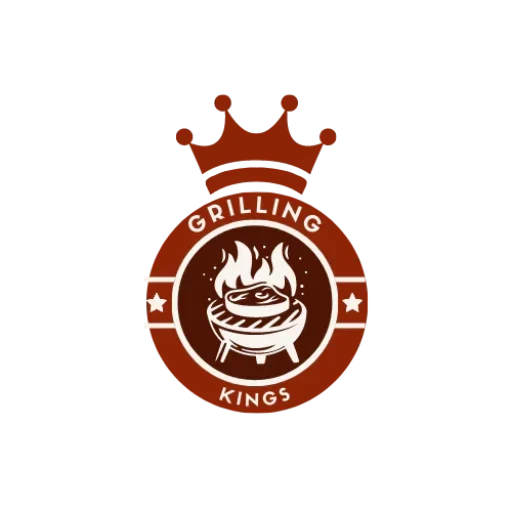

[…] a vegetarian looking for delicious and flavorful options or simply want to explore vegetable grilling techniques, these marinades will satisfy your cravings and make your taste buds dance with […]
[…] leaving some fat can enhance flavor and juiciness. Remember to adjust cooking time and use proper grilling techniques for optimal […]